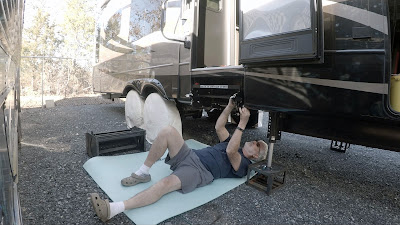The only thing we hated about our 2015 Montana 3611RL was how Keystone put the Washer / Dryer setup. We have put up with it for a little over a year, and I decided we had enough of the Stupid Keystone Engineer that designed the Washer / Dryer hookup on our 2015 Montana 3611RL. See earlier blog post that covered initial install. Shakedown Cruise and Washer / Dryer Combo Installed. You have to move (or remove) your cloths to get to the Washer / Dryer. Not good when you are going to be on the road for several months.
 |
| The mirror panels on the Left and Right are fixed and do not slide. |
 |
| The two center panel open, and you can see the way Keystone Engineer put the washer/dryer. |
First step was to remove right panel. About 2.5 inches from the top of the panel had to be cut off to put at the bottom so the panel could slide over the center section. That 2.5 inch piece is used at the bottom, to raise the panel above the center section.
 |
| If you look at the bottom you will see where the Right panel goes below the center section, so it cannot slide to the right. |
Since existing doors used full extension draw slides, I followed the same method.
 |
| Below the Combo Washer/Dryer you can see the draw slide. |
The only other gotcha I had was the dryer vent. There was no way to re-use the current vent, so I had to put in a new one.
 |
| Here you can see the new vent installed up in the black paint area. Since there is more room to run the duct to the new vent, it doesn't have the sharp turns the old had. |
 |
| New Dryer Vent Duct. I made a big hole in the back to make connections easier for maintenance. The shoe case on the front cap wall can easily be removed for more access. Something that original layout did'n't have. |
I also raised the power plug to above the unit so the plug doesn't have a sharp bend in it.
 |
| Plug relocated above Unit. |
I still have some clean up work to do, but over all I am pleased with the re-design, since we use our Combo Washer / Dryer a lot.
 |
| Notice the right panel is not lined up with others, this is because it needs to slide over the center fixed section, so I had to raise the panel 2.5 inches to clear that section. |
 |
| Closet Doors open |
 |
| Right panel open so you can do Landry. Still need to put bottom panel on Combo unit and re-screw down the seat. Washer door opens with 2-3 inches of clearance over the seat. |


























































